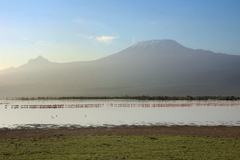
Kilimanjaro is often obscured by clouds or
haze. This was as good is it got on my last trip
there.
Amboseli is one of Kenya's flagship parks, and is a UNESCO man and biosphere reserve. You can see its position on the Amboseli/Selenkay (map).
The name 'Amboseli' is derived from the Maasai word 'empusel' meaning 'salty dusty place'. It is at the core of an 8000 km2 ecosystem that crosses the Kenya-Tanzania border. It was gazetted as a national park in 1974.
Kilimanjaro is the park's famous backdrop. It is the highest mountain in Africa and the highest single free-standing mountain on the planet and is a dormant, but not extinct, stratovolcano. It has three peaks. Kibo, the highest stands at 5,895m (19341 ft) amsl. The summit on Kibo is known as Uhuru Peak. The lower peaks are Mawenzi and Shira.
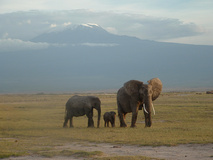
Elephants posing with Kilimanjaro in the
background on a clearer day many
years ago with a 2MP camera. As good
as it got back then
Sadly, the icefields on the top are retreating and at present rates they will be gone by 2060.
You can get the iconic photos of elephants with the mountain in the background on days when it is clear. But don't hold your breath. The mountain likes to hide behind mist or cloud most of the time.
Rainfall is bimodal. Short rains in October to December, then a lull, and then longer heavier rains from March to May. Rainfall can vary from 200mm -700mm with an average of around 350mm. However the second year I visited there had been a very prolonged drought in East Africa and the park was parched almost to bare earth except nearer to the swamps and lakes.
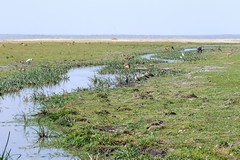
The grassland is much greener close to the
marshes. Underground streams from
Kilimanjaro eventually surface in the park
Vegetation in the park is mostly open savannah grassland, with some small woodland areas. Years ago there was a lot more woodland but a lot of trees died off. It was thought to be partly due to elephant damage, but it was found that changes in the water table in the Kilimanjaro area caused progressive increases in the levels of soluble salts in the soil.
This increased salinity caused a die back of woodlands like the fever trees from 25% to 5% and an increase of more salt tolerant plant types, mostly bushes, and grasslands. This is causing a decline of biodiversity within the park.
There are five main swamps within the park. Some appeared more like lakes to me. They are largely fed by underground springs supplied by water running off Kilimanjaro.
The park also protects a dried up Pleistocene lake in the west. A remnant of wetter times. Nowadays the area is classed as semi-arid.
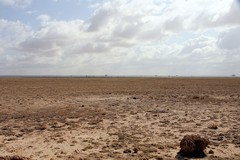
The prolonged drought had scorched much
of the plant life so nothing was left. Only
consistent rain would restore it. Although the
plants are adapted to these conditions it was
too much for a lot of the wildlife, which moved
into dispersal areas such as Selenkay
The drought in 2023 was due to the triple dip 'La Nina' weather cycle which is part of the El Nino Southern Oscillation (ENSO). ENSO is one of the most important climate phenomena on Earth due to its ability to change the global atmospheric circulation, which in turn, influences temperature and precipitation across the globe.
It comes in three phases and is a bit erratic in when it occurs but we get an El Nino event every few years.
El Nino: A warming of the ocean surface, or above-average sea surface temperatures, in the central and eastern tropical Pacific Ocean. Over Indonesia, rainfall tends to become reduced while rainfall increases over the tropical Pacific Ocean. East Africa gets above average rainfall.
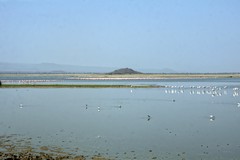
Observation hill in the distance. You can walk
up it and there's a seating area at the top
La Nina: A cooling of the ocean surface, or below-average sea surface temperatures, in the central and eastern tropical Pacific Ocean. Over Indonesia, rainfall tends to increase while rainfall decreases over the central tropical Pacific Ocean. The normal easterly winds along the equator become even stronger. East Africa gets below average rainfall.
The third phase is neutral. In general these events are tending to become stronger and happen more often.
Amboseli National Park offers some of the best opportunities to see African wildlife because the vegetation is sparse due to the long, dry months, which inhibits tree growth and allows savannah to continue. There is no off-road driving, but it doesn't detract from the sightings as the animals are used to traffic, and are not easily scared off.
Over 80% of wildlife leaves Amboseli national park during the wet season to disperse into the surrounding group ranches once new food and water is available. Group ranches are vital for the majority of wildlife, and it is critical that migration routes are kept open, otherwise the ecosystem will collapse. When the dry season hits the wildlife gradually returns to the core Park, attracted by the permanent marshes.
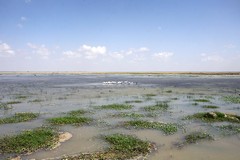
Waders love Amboseli
Some areas such as Selenkay have set up dedicated conservancies and facilitated tourism.`
The park is famous for being the best place in the world to get close to elephants. The are over 1600 Elephant individuals that freely roam here and over the rest of the ecosystem. There are no rhino. They were poached out. There are around 100 lions.
Amboseli is famous for its super tusker elephants. One such was named Tim and he appeared in numerous TV documentaries. He died on february 5th 2020 from natural causes. There are more, but not many, and trophy hunters recently (October 2023) murdered two of them just across the border in Tanzania.
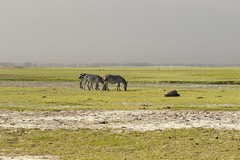
Amboseli is characterised by wide open areas
of flat savannah, and short grass. The amount
of woodland has decreased over the last thirty
or so years, mostly due to more minerals in the
soil which increased its salinity. The minerals
are associated with a raised water table
There are plenty of giraffes, spotted hyaenas, zebras, buffalos, wildebeest, cheetahs, lions, Grant's and Thompson's gazelles and many more. I'd like to mention the Bohor reedbuck, as they are well accustomed to tourists and this is the only place I know where they haven't bolted for cover as soon as they see a Landcruiser.
Over 400 species of birds have been observed here, Some are winter migrants that visit from November to April. 47 types of raptors have been recorded. It is a fantastic park for waterbirds due to the lakes and swamps. Huge amounts of birdlife inhabit the watery parts of the reserve.
In recent years, a historical threat to wildlife has resurfaced in the ecosystem. There has been a significant increase in the use of poisons like cyanide for lacing prey carcasses to kill carnivores. Unfortunately it also kills scavengers and vultures.
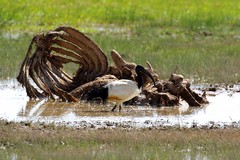
The scattered localised showers in the short
rains were just too late for some
Conflict mitigation has become very important. One of the ways it is managed is by a group of locals known as the lion guardians. They monitor and track lions and warn people if lions are heading their way. The also assist in building lion proof bomas. They estimate that they prevent around 2 million dollars worth of livestock predation a year, and prevent up to 50 lion hunts from taking place.
We are always taking land, and predators are losing territory, and animals to hunt, due to a reduction in prey base and bushmeat poaching. When that happens predators are almost forced to hunt livestock.
There is a Chagga legend pertaining to the formation of Kilimanjaro. A man named Tone once provoked a god, Ruwa, to bring famine upon the land. The people became angry at Tone, forcing him to flee. Nobody wanted to protect him except for a solitary dweller who had stones that turned miraculously into cattle.
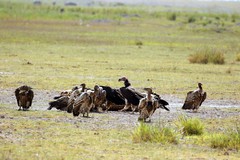
There are always winners and losers.
Scavengers seemed to be doing very well due
to the abundance of victims of the drought
The dweller said that Tone must never open the door of the cattle stable but, of course, Tone did not heed the warning, opened the stable and the cattle escaped. Tone followed them, but the fleeing cattle threw up hills to run on, including Mawenzi and Kibo. Tone finally collapsed on Kibo. What happened after that is a mystery.
Another Chagga legend tells of ivory-filled graves of elephants on the mountain.
Overall I'd say Amboseli is a great place to get shots of animals and definately of water birds. When attempting longer distance shots like many of these on this page there can be a problem with heat haze during the hotter parts of the day.
This park has heavy traffic, which to me seriously detracts from the feeling of being in the wild. because the roads often run alongside wet areas they tend to be raised a little, and traffic jams can often occur, with no option but to wait as wildlife has the right of way.
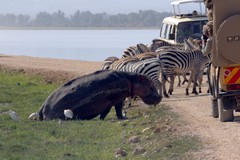
It's easy to get held up in Amboseli as it's
difficult to get around the road block
Also, apart from Observation hill, which you can walk up, it is very flat and scenically uninteresting savannah.
It's probably my least favourite reserve, but nice to see Kilimanjaro if you are lucky.
Since my last visit in 2023 the climate shifted to an El Nino pattern which generally brings above average rain to East Africa. These cycles just keep repeating and the severity of the droughts depend on the strength of La Nina. Climate change is affecting the ENSO making swings bigger and more common.